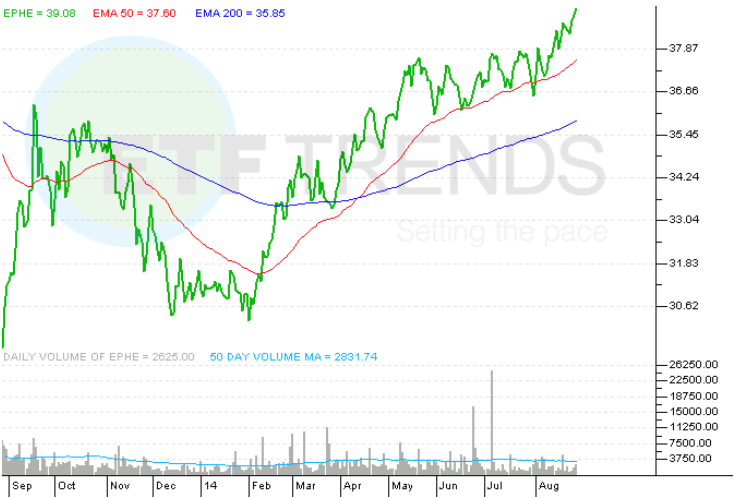MarketMuse update courtesy of ETF Trends’ Todd Shriber.
After finishing lower for a second consecutive year in 2014, diversified emerging markets exchange traded funds are off to decent though not spectacular starts in 2015.
Off to a more impressive start than broader peers, such as the iShares MSCI Emerging Markets ETF (NYSEArca: EEM) and the Vanguard FTSE Emerging Markets ETF (NYSEArca: VWO), is the iShares MSCI Philippines ETF (NYSEArca: EPHE). EPHE, the lone Philippines ETF, entered Friday with a 2015 gain of 2.6%, or nearly quadruple that of VWO.
In 2014, EPHE gained more than 22% while EEM and VWO each finished the year in the red. EPHE now resides less than 10% below its all-time high set in January 2013 and more gains could be on the way after stocks in Manila rose to a record during Friday’s Asian session.
Like India, the Philippines is getting a significant economic boost from lower oil prices because the Philippines is dependent on oil imports to help power one of Southeast Asia’s fastest-growing economies. Over the past six months, the U.S. Oil Fund (NYSEArca: USO) has plunged 51%, but the WisdomTree India Earnings Fund (NYSEArca: EPI) and EPHE have traded modestly higher over that period.
Investors are paying up to be involved with Philippine equities.
“Shares in the Philippine Stock Exchange Index are valued at 18.4 times 12-month estimated earnings, the highest since Nov. 26. The gauge has the highest multiple among Asia’s benchmark equity indexes,” reports Michael Patterson for Bloomberg.
The MSCI Emerging Markets Index trades at about 11 times earnings, but that did not prevent EPHE from hauling in $44.3 million in new assets last year. That is nearly 12% of the ETF’s current assets under management, indicating U.S. investors remain underweight Philippine equities. That may not be the case for long.
“The Taiwanese, Philippine and South Korean stock markets also warrant over-emphases on account of their stable political regimes, reliable policymaking climates and healthy economic prognoses,” said S&P Capital IQ.
For 2015, Morgan Stanley “said the Philippines was the best-positioned market due to its ample liquidity, strong forecast gross domestic product growth and low levels of credit penetration,” reports The Star.
A stronger U.S. dollar is helping Philippine stocks beyond lower oil prices. Foreign remittances are now worth more when converted into pesos, helping boost the local economy. EPHE allocates nearly 12% of its weight to consumer sectors.
In fact, the Philippines has already issued dollar-denominated bonds this year, becoming the first emerging market to do so. The Philippines can afford to do that because its external funding costs are low relative to other developing economies and the country has an investment-grade rating from all three major ratings agencies.
For the original article by Todd Shriber from ETF Trends, click here.

